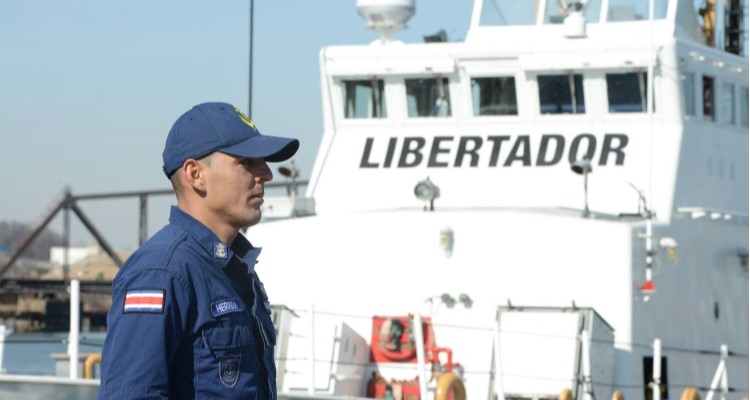March 6, 2018 —

Costa Rica Coast Guard 1st Agent Davis Herrera stands watch over a former U.S. Coast Guard 110-foot patrol boat at the Coast Guard Yard in Curtis Bay, Maryland, Feb. 13, 2018. Two of the former U.S. Coast Guard cutters were formally transferred to Costa Rica in October 2017 and will be commissioned in Caldera this April. U.S. Coast Guard photo by Petty Officer 3rd Class Ronald Hodges.
The U.S. Coast Guard hosted a delegation of officials from the Costa Rica Coast Guard at the Coast Guard Yard in Curtis Bay, Maryland, Feb. 13. The meeting affirmed the nations’ commitment to regional maritime security and law enforcement as Costa Rica moves closer to operating the two 110-foot patrol boats it received through a transfer last fall.
The Coast Guard formally transferred the two patrol boats – the former cutters Long Island and Roanoke Island – to Costa Rica through the Excess Defense Articles (EDA) Program in October 2017. The ships have since been outfitted with new radar, communications equipment and paint; they are currently stationed at the Coast Guard Yard for maintenance. U.S. Coast Guard crews are working with their Costa Rican counterparts on training and familiarization on the ships.
The two former cutters will be commissioned as Costa Rica Coast Guard Libertador-class vessels Juan Rafael Mora Porras and Gen. Jose M. Canas Escamilla in the country’s port of Caldera this April.
Adm. Charles D. Michel, Coast Guard vice commandant, underscored the importance of the ships during their decades of service in the U.S. Coast Guard and of the work that they will continue to carry out as assets of the Costa Rica Coast Guard. “These two vessels being transferred served proudly in one of our nation’s harshest environments: in the waters off Alaska,” he said. “The crews aboard these great workhorses halted poachers, secured our waters and saved lives. Now Costa Rica will breathe new life into these highly capable platforms, and their new crews will do the same in the pristine and warmer waters off the coast of their new home in Caldera.”
Sharon Day, the U.S. ambassador to Costa Rica, emphasized the vital role the ships will play in Caribbean drug interdiction. “The transfer of these cutters will transform Costa Rica’s abilities to patrol its extensive waters and fight drug trafficking and other illicit activities – and a safer and more secure Costa Rica means a safer and more secure United States. Every ounce of drugs seized by the fine women and men of the Coast Rica Coast Guard is potentially an ounce less that will find its way onto our streets in the United States.”
In addition to building and sustaining international partnerships and regional maritime safety and security, each 110-foot patrol boat transfer saves the Coast Guard money in remediation and disposal costs. “These boats have served the U.S. Coast Guard well,” said Rear Adm. Michael J. Haycock, Coast Guard assistant commandant for acquisition. “If the costs weren’t climbing on each of these, they’d still be in operation.”
The Coast Guard has also transferred two 110-foot patrol boats to the Georgian coast guard and two to the Pakistan Maritime Security Agency. The multimission 110-foot Island-class patrol boats entered service in the mid-1980s and are being replaced with 58 154-foot fast response cutters, 25 of which are in service.
For more information: Excess Defense Articles Program page